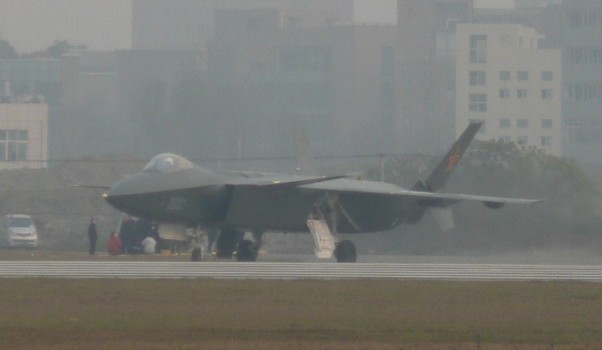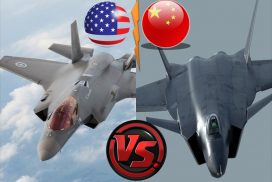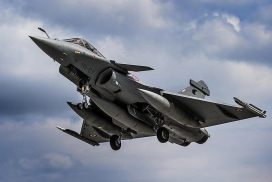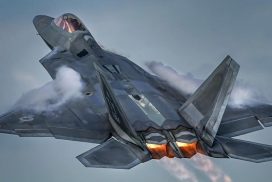China recently showed the world its latest fighter aircraft in a typical Chinese way with the Govt media denying it but allowing Chinese hobbyist to upload images of the aircraft on the internet. According to latest reports the aircraft is carrying high speed taxi run and is expected to take to the skies anytime. A Chinese stealth aircraft will definitely change the balance in the region in favor to an extent in favor of China. Before we can analyze the implications we first need to analyze the aircraft.
Design: The J-20 is delta win canard configuration with V-Shape tail and has two S-Shaped DSI inlets. The aircraft is probably the biggest 5th Gen aircraft and is approximately 60-65 feet long. It has a bubble canopy similar to the F-22. Overall the aircraft uses Chinese experience on the J-10 and JF-17 in wing and inlets area. Most other aspects are taken from the success of the American F-22.
Threat: The aircraft is abnormally large in size which indicates that the aircraft will have high weapons and fuel payload capacity giving it long range and capacity to carry a lot more weapons than any other 5th Gen fighter. The nose is also well designed keeping in mind possibly large AESA radar. The overall design of the aircraft is very good and should make it much stealthier than the Russian PAK-FA (if it remains the way it is). The aircraft is stated to get a 180 kN capacity engine which will give it a decent kinematic performance. Chinese production capability is probably the best in the world, PLAAF can get hundreds J-20’s within a very short span.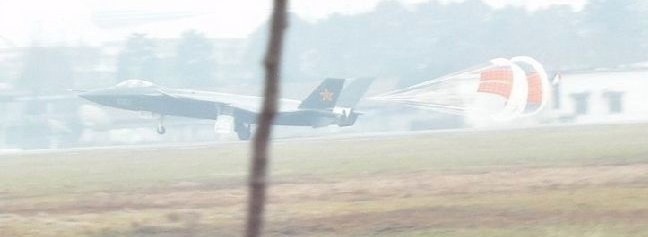
Weakness: The canards are not good to maintain a very low observability profile as they increase the RCS. The current prototype is most probably carrying avionics system developed for the current line of 4th Gen aircrafts which are not the most advance in the world. China still has long way to go in composite materials thus the aircraft will have much higher maximum take-off weight. This is followed by China’s inability to build a reliable turbo-jet engines as it is yet to perfect a 90kN engine for the JF-17. Chinese designers have taken note of these deficiencies and have made the airframe suitably. The aircraft will carry a large payload of less sophisticated weapons rather than small number of highly sophisticated weapons, the aircraft has some 6 control surface (which includes the canard) and more fuel to burn to meet kinematic requirements and be somewhat comparably to the superior and better engineered American and Russian 5th Gen fighters. Also the aircraft is as good as its pilots and according to American, Japanese and Taiwanese assessments the Chinese pilots are not as skilled as American, Indian and Japanese pilots who have International exposure in air combat. Also the PLAAF is unproven force where as most of its adversaries are combat experienced.
IMPLICATION: In last few decades the aggressive behavior of the Chinese govt has made countries like US, Japan & South Korea to consider China as a military rival along with countries who already have a long standing border dispute (India, Vietnam & Taiwan). Most of these countries have a firm 5th generation Plans with South Korea and Japan considering the F-35. Japan is also developing its own 5th Gen Fighter for research purpose. US already have F-22 and the F-35 is in making. India is already committed to the Russian PAK-FA project and is also developing its own 5th Gen Fighter named AMCA. Meanwhile Vietnam is expected to be the first customer of the PAK-FA.
The J-20 will mostly enter service in the 2020 time frame and by than the PLAAF will have approximately 200 Chinese made Flanker series aircrafts along with some 500 J-10 series aircrafts. Most of the older inventory will be retired. The order for J-20 could well go above 500. However the US Navy will itself have some 700 Hornet series aircraft along with hundreds other much more advance fighters with her allies namely Taiwan, Japan and South Korea. India will also have about 600 advance 4th Gen aircrafts. So though the PLAAF air fleet is sizable it is still not comparably with a larger and much more advance American fleet and a smaller but a more advance Indian Fleet.
US & Allies: US and its allies are least likely to be affected by the J-20 because of their traditional technological and numerical superiority. Also the American F-22 and F-35JSF are technologically much more mature than the J-20. If US and China go to war post 2020 the Americans will still win but should take heavier loss than now and most of them would be caused by the J-20
India: India is likely to be affected by the Chinese J-20 as the IAF has smaller fleet of aircrafts and can suffer from reduced margin of safety with higher attrition. However India has an advantage with better 4th Gen fighters, advance weaponry and systems, better Pilots and experience. India also has an advantage with the single seater PAK-FA which is in advance stage of development. The Twin seater version will also enter service within the same time frame or before as it will be based on the single seater version. India also has added advantage of testing 5th gen avionics and subsystem on Tejas Mk-2 fighter and the PAK-FA which should reduce the development time of AMCA. India has taken note of the J-20 and has launched an official study on it. J-20 will affect India moderately.
Vietnam: Vietnam never had an advantage over the PLAAF as bulk of its fleet consists of older MiG-21’s. J-20 will have most sever implication for Vietnam as its already obsolete air force will suffer even poorly in the hands of J-20. This could force Vietnam to order larger numbers of PAK-FA and possibly replace the MiG-21’s with a better 4th Gen fighter.
Conclusion: J-20 is very promising start for China and the aircraft is designed well keeping in mind China’s strength and weakness. J-20 will be a fighter to reckon with for China’s adversaries. But the world should take J-20 as a natural step on its natural course which China has been taking for past decades. Also China should not consider the J-20 as the silver bullet which will give her global air dominance as that title will be shared by the American F-22 and the Russian-Indian PAK-FA/FGFA.

